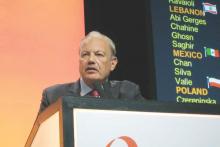SAN ANTONIO – Final 10-year analysis of the landmark BCIRG-006 trial underscores the safety advantages of a nonanthracycline, trastuzumab-based adjunctive treatment regimen in early-stage HER2-positive breast cancer.
At a median 10.3 years of follow-up in the phase III randomized trial of 3,222 patients, a substantial reduction in the risk of cardiac toxicity was evident in the women assigned to six cycles of docetaxel (Taxotere) and carboplatin plus 1 year of trastuzumab (the TCH arm), compared with the two anthracycline-containing study arms, Dr. Dennis J. Slamon reported at the San Antonio Breast Cancer Symposium.
At baseline the three treatment groups were well balanced in terms of cardiovascular risk factors. Yet over the course of the study only 4 women in the TCH arm developed clinical heart failure, compared with 21 patients who received four cycles of doxorubicin (Adriamycin) and cyclophosphamide (Cytoxan) followed by four cycles of docetaxel and 1 year of trastuzumab (AC-TH), and 8 patients in the control arm who got four cycles of doxorubicin and cyclophosphamide followed by four cycles of docetaxel (AC-T).
Thus, adding docetaxel to 1 year of trastuzumab (Herceptin) conferred a fivefold increase in this major cardiac complication, compared with trastuzumab alone, noted Dr. Slamon, professor of medicine and chief of the division of hematology-oncology at the University of California, Los Angeles.
His presentation of the final analysis also provided important new information on the issue of treatment-related subclinical reductions in cardiac reserve as manifest by decreased left ventricular ejection fraction (LVEF).
A greater than 10% reduction in LVEF occurred in 9.4% of the TCH group, 19.2% of the AC-TH group, and 11.8% of the AC-T control group. In 2009 when Dr. Slamon presented the 5-year follow-up of BCIRG-006 at the San Antonio Breast Cancer Symposium, he was able to report that during the first year post treatment the no-anthracycline TCH group showed a recovery of LVEF to near baseline while in the AC-TH and AC-T groups the LVEF did not bounce back through the 5-year mark. The question raised at that point was how long would their LVEF remain diminished.
“With the 10-year data, with LVEFs measured annually after the end of treatment, this loss is real and is maintained. The question now is, what will become of these patients when they acquire their long-term age-related cardiac risk factors after we’ve already compromised their LVEF to some degree?” he said.
The primary endpoint in BCIRG-006 was disease-free survival (DFS). At final follow-up, with a total of 876 such events, the DFS rate was 74.6% in the AC-TH group and statistically similar at 73% in the TCH group, both of which were superior to the 67.9% figure in the AC-T control arm. Only 10 DFS events separated the TCH and AC-TH groups at 10 years. Overall survival rates in the two trastuzumab arms weren’t significantly different either.
To answer the question of whether patients with higher-risk HER2-positive early breast cancer require anthracycline-based adjunctive therapy in order to maximize benefit, the investigators did a subanalysis restricted to the roughly 400 women with four or more positive lymph nodes. The DFS rate was 62.9% with TCH and a near-identical 62.8% with AC-TH, both superior to the 53.6% DFS rate in the AC-T group.
All eight cases of acute leukemia occurred in the AC-TH and AC-T study arms.
The study was sponsored by Sanofi with additional support from Genentech. The presenter reported serving on advisory boards for BioMarin, Genentech/Roche, Pfizer, and Novartis.


